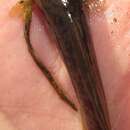Kwando River System Habitat
(
İngilizce
)
EOL authors tarafından sağlandı
The Kwando River system is generally construed to consist of the upper Kwando originating in the Angolan headwaters, the middle reach Linyanti swamps and the lower reach Chobe River. The blunt-nosed African catfish (Clarias ngamensis) is a demersal species particularly prevalent in the swampy mid reaches of the river system, where heavily vegetated, shallow and slow moving flow regimes persist. Ion concentrations jgenerally in the rapid flowing river mainstem tends to be low in ionic content; however, swampy areas often contain higher concentrations of nitrate and other ionic components. Correspondingly, planktonic content is only appreciable at these slackwater portions of the river, notably in the Linyanti Swamp. The Kwando waters generally exhibit a lower pH level than the neighboring Okavango River, but have a slightly higher sulfate concentration. The largest native demersal fish species in the Kwando is the 117 centimeter (cm) long tiger fish (Hydrocynus vittatus). Other large demersal native species are the 70 cm Kafue pike (Hepsetus odoe), and the 50 cm western bottlenose mormyrid (Mormyrus lacerda} . Each of these demersal vertebrate species are assigned a high trophic level (in the vicinity of level four).
- bibliyografik atıf
- C.Michael Hogan. 2012. Kwando River. Eds. P.Saundry & C.Cleveland. Encyclopedia of Earth. National Council for Science and the Environment. Washington DC
- yazar
- C. Michael Hogan (cmichaelhogan)
Diagnostic Description
(
İngilizce
)
Fishbase tarafından sağlandı
Characterized by a relatively long vomerine tooth plate (5.9-14.4 % HL) and by a relatively short adipose fin (5.9-12.5 % SL), the length of which is a specific character of C. ngamensis. Head oval to rectangular in dorsal outline; frontal fontanelle long and narrow (`knife-shaped'); occipital fontanelle small and oval-shaped. Pectoral spine robust and slightly curved. The suprabranchial organ consists of well developed arborescent structures.
- Recorder
- Crispina B. Binohlan
Life Cycle
(
İngilizce
)
Fishbase tarafından sağlandı
Breeding is reportedly flood dependent and similar to that of C. gariepinus.
- Recorder
- Crispina B. Binohlan
Migration
(
İngilizce
)
Fishbase tarafından sağlandı
Potamodromous. Migrating within streams, migratory in rivers, e.g. Saliminus, Moxostoma, Labeo. Migrations should be cyclical and predictable and cover more than 100 km.
- Recorder
- Crispina B. Binohlan
Morphology
(
İngilizce
)
Fishbase tarafından sağlandı
Dorsal spines (total): 0; Dorsal soft rays (total): 56 - 62; Analsoft rays: 50 - 58; Vertebrae: 56 - 60
- Recorder
- Crispina B. Binohlan
Trophic Strategy
(
İngilizce
)
Fishbase tarafından sağlandı
Inhabits swamps and river mouths. Frequency of occurence in Caprivi: frequently in sandy streams, common in standing deep water, abundant in shallow swamps (Ref. 037065). Feed mainly on fish as well as on detritus, plants and benthic invertebrates especially mollusks (Ref. 248, 12597). Uncommon in the Lake Nyasa basin (Ref. 4967).
- Recorder
- Crispina B. Binohlan
Biology
(
İngilizce
)
Fishbase tarafından sağlandı
The species seems to be nowhere especially abundant but is fairly common in some areas such as weed beds, permanent swamps, quieter waters and muddy bottoms (Ref. 248, 5595). Prefers vegetated habitats. Feeding habits overlap considerably with the sharptooth catfish. Important foods are mollusks, terrestrial and aquatic insects, insect larvae, shrimps, grain, crabs and fish (Ref. 4967, 78218). Feeds on snails (Ref. 5595). Hard-shelled foods such as mussels are crushed before they are swallowed. Breeds during the summer rainy season. May live for 5-6 years (Ref. 7248). Also caught with drawnets (Ref. 4967).
- Recorder
- Crispina B. Binohlan
Importance
(
İngilizce
)
Fishbase tarafından sağlandı
fisheries: commercial; aquaculture: commercial; gamefish: yes; aquarium: commercial
- Recorder
- Crispina B. Binohlan

